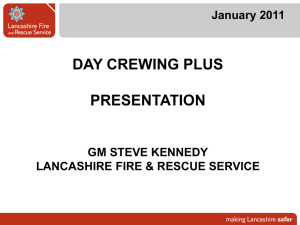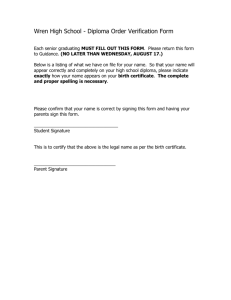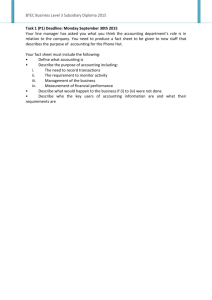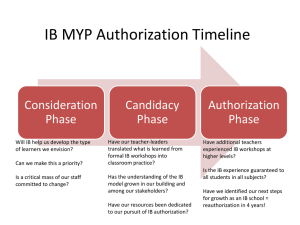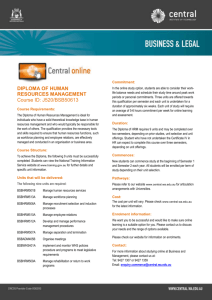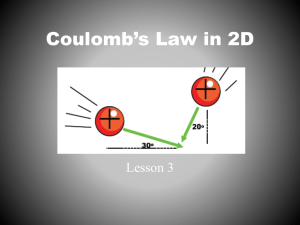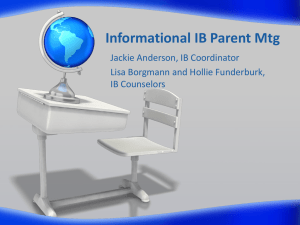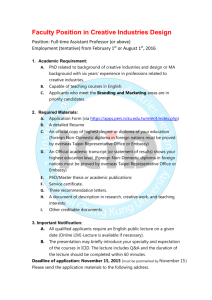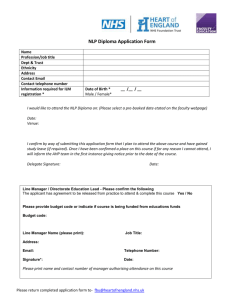Group 4 Physics
advertisement
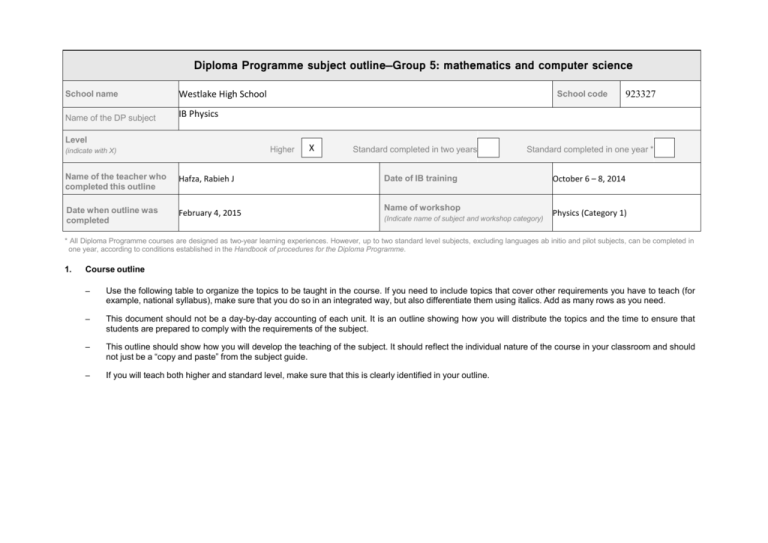
Diploma Programme subject outline—Group 5: mathematics and computer science School name Westlake High School Name of the DP subject IB Physics School code Level Higher (indicate with X) Name of the teacher who completed this outline Hafza, Rabieh J Date when outline was completed February 4, 2015 X Standard completed in two years 923327 Standard completed in one year * Date of IB training Name of workshop (Indicate name of subject and workshop category) October 6 – 8, 2014 Physics (Category 1) * All Diploma Programme courses are designed as two-year learning experiences. However, up to two standard level subjects, excluding languages ab initio and pilot subjects, can be completed in one year, according to conditions established in the Handbook of procedures for the Diploma Programme. 1. Course outline – Use the following table to organize the topics to be taught in the course. If you need to include topics that cover other requirements you have to teach (for example, national syllabus), make sure that you do so in an integrated way, but also differentiate them using italics. Add as many rows as you need. – This document should not be a day-by-day accounting of each unit. It is an outline showing how you will distribute the topics and the time to ensure that students are prepared to comply with the requirements of the subject. – This outline should show how you will develop the teaching of the subject. It should reflect the individual nature of the course in your classroom and should not just be a “copy and paste” from the subject guide. – If you will teach both higher and standard level, make sure that this is clearly identified in your outline. Allocated time Topic/unit (as identified in the IB subject guide) Contents in one week there are State the topics/units in the order you are planning to teach them. Topic 1: Measurements & Year 1 Uncertainties o o o o o o o Topic 2: Mechanics One class is o o o o o 1.1 SI Units and Derivations 1.1 Scientific Notation & Dimensional Analysis 1.1 Significant Figures 1.1 Estimation 1.2 Calculating Uncertainty 1.2 Calculating Error and Error Bars 1.3 Trigonometry and Vectors 8 hours 2.1 Kinematics Motion in 1 Dimension Graphing Motion Projectile Motion 2.2 Dynamics Free Body Diagrams Newton’s Laws of Motion Translational Equilibrium Friction 2.3 Energy Work Kinetic and Potential Energy Work-Energy Theorem Law of Conservation of Energy Power Efficiency 2.4 Momentum & Impulse Momentum Impulse Law of Conservation of Momentum Collisions 25 Hours 90 minutes. 2-3 classes. Assessment instruments to be used Unit Test Quizzes Unit Problem Sets Worksheets Resources List the main resources to be used, including information technology if applicable. Textbooks Workbooks Guidebooks Probeware Interactive Whiteboard Video Analysis iPad 2 Application for authorization: Diploma Programme Allocated time Topic/unit (as identified in the IB subject guide) Contents in one week there are State the topics/units in the order you are planning to teach them. Topic 6: Circular motion & Gravitation o o o Year 1 Topic 3: Thermal Physics One class is o o 6.2 Newton’s Law of Gravitation Finding g Gravitational Field 6.1 Circular Motion Centripetal Force & Acceleration Angular Displacement, Velocity, and Acceleration Period and Frequency 7 Hours 3.1 Thermal Concepts Molecular Theory of States of matter Temperature Internal Energy Specific Heat Latent Heat Phase Changes 3.2 Modeling a Gas Pressure Moles and Conversions Ideal Gas Law versus Real Gases State of Ideal Gas Kinetic Model of Ideal Gases 15 Hours 90 minutes. 2-3 classes. Assessment instruments to be used Unit Test Quizzes Unit Problem Sets Worksheets Resources List the main resources to be used, including information technology if applicable. Textbooks Workbooks Guidebooks Probeware Interactive Whiteboard Video Analysis iPad 3 Application for authorization: Diploma Programme Allocated time Topic/unit (as identified in the IB subject guide) Contents in one week there are State the topics/units in the order you are planning to teach them. Topic 4: Waves One class is 90 minutes. 2-3 classes. Assessment instruments to be used Resources List the main resources to be used, including information technology if applicable. o 4.1 Oscillations 18 Hours Simple Harmonic Motion Graphs of SHM Period, frequency, amplitude and phases o 4.2 Traveling Waves Wave Speed Transverse & Longitudinal waves Electromagnetic Waves Sound Waves o 4.3 Wave Characteristics Wave fronts & rays Amplitude & Intensity Superposition Polarization o 4.4 Wave Behaviour Reflection & Mirrors Indices of Refraction Refraction & Lenses Single Slit Diffraction Double Slit Interference o Standing Waves Nature and Formation of Standing Waves Structure of Standing Waves Harmonics on Strings and Pipes 4 Application for authorization: Diploma Programme Allocated time Topic/unit (as identified in the IB subject guide) Contents in one week there are State the topics/units in the order you are planning to teach them. Year 1 Topic 9: Wave Phenomena** One class is o o o o o 9.1 Simple Harmonic Motion Velocity, Acceleration, & Displacement in SHM Energy in SHM Energy transfer in SHM 9.2 Single Slit Diffraction Diffraction Pattern First Interference Minimum Light Frequencies 9.3 Interference Young’s Double Slit Experiment Modulation by One Slit Diffraction Pattern Diffraction Gratings Thin Film Interference 9.4 Resolution Rayleigh Criterion Resolvance of Diffraction Gratings 9.5 Doppler Effect Sketching Doppler Effect Doppler Effect Examples Solving Doppler Effect 20 Hours 90 minutes. 2-3 classes. Assessment instruments to be used Unit Test Quizzes Unit Problem Sets Worksheets Java Applets Probeware Resources List the main resources to be used, including information technology if applicable. Textbooks Workbooks Guidebooks Probeware Interactive Whiteboard Video Analysis iPad 5 Application for authorization: Diploma Programme Allocated time Topic/unit (as identified in the IB subject guide) Contents in one week there are State the topics/units in the order you are planning to teach them. Topic 8: Energy Production One class is 90 minutes. 2-3 classes. Assessment instruments to be used Resources List the main resources to be used, including information technology if applicable. o 8.1 Energy Sources 12 Hours Specific Energy & energy Density problems Sankey Diagrams Primary Energy Sources Electricity Energy Sources (Renewable/NonRenewable) o 8.2 Thermal Energy Transfer Conduction, Convection, & Radiation Black Body Radiation, StefanBoltzman’s Law, Wien’s Displacement Law o Albedo, Emissivity, Solar Constant, The Green House Effect, and Earth’s Average Temperature 6 Application for authorization: Diploma Programme Allocated time Topic/unit (as identified in the IB subject guide) Contents in one week there are State the topics/units in the order you are planning to teach them. Year 2 Topic 5: Electricity & Magnetism o o o o o Topic 10: Fields** One class is o o 5.1 Electric Fields 20 Hours Charges and Forces Coulomb’s Law & Electric Field Work & Energy in Electric Fields Metals, Charge, & Drift Speed Charge, Current, and Potential Difference 5.2 Heating Effect of Electric Currents Parallel, Series, & Combination Circuits Ohm’s Law Voltmeter’s & Ammeters Ohmic & Non-Ohmic Devices Resistivity Kirchhoff’s Circuit Laws Power Dissipation 5.3 Electric Cells Cells (Primary & Secondary Internal Resistance, Terminal Potential Difference, & Emf 5.4 Magnetic Effects of Electric Currents Magnetic Fields Magnetic Force: Charge moving through a field Magnetic Force: Current Carrying Wire in a field 90 minutes. 2-3 classes. Assessment instruments to be used Unit Test Quizzes Unit Problem Sets Worksheets Java Applets Probeware Resources List the main resources to be used, including information technology if applicable. Textbooks Workbooks Guidebooks Probeware Interactive Whiteboard Video Analysis iPad 10.1 Describing Fields 15 Hours Field Lines and Patterns Potential Lines Work Done in A Field 10.2 Fields at Work Potential Energy & Fields Electric & Gravitational Potential Orbital Motion, Orbital Speed, & Orbital Energy 7 Application for authorization: Diploma Programme Allocated time Topic/unit (as identified in the IB subject guide) Contents in one week there are State the topics/units in the order you are planning to teach them. Topic 11: Electromagnetic Year 2 Induction** One class is o 11.1 Electromagnetic Induction Electromotive Force (Emf) Magnetic Flux & Linkage Faraday’s Law of Induction Lenz’s Law o Power Generation & Transmission Alternating Current (AC) Generators Average Power Transformers Diode, Half-wave, & Full Wave Rectification o 11.3 Capacitance Parallel Plate Capacitors & Dielectrics Capacitors in series and parallel Energy in Capacitors Discharge of Capacitors RC Series Circuits and Time Constant 20 Hours 90 minutes. 2-3 classes. Assessment instruments to be used Unit Test Quizzes Unit Problem Sets Worksheets Java Applets Probeware Resources List the main resources to be used, including information technology if applicable. Textbooks Workbooks Guidebooks Probeware Interactive Whiteboard Video Analysis iPad 8 Application for authorization: Diploma Programme Allocated time Topic/unit (as identified in the IB subject guide) Contents in one week there are State the topics/units in the order you are planning to teach them. Topic 7: Atomic, Nuclear, & Particle Physics o o o Topic 12: Quantum & Nuclear Year 2 Physics** One class is o o 90 minutes. 2-3 classes. Assessment instruments to be used Resources List the main resources to be used, including information technology if applicable. 7.1 Discrete Energy & Radioactivity 15 Hours Discrete Energy, Energy Levels, Transitions, & Calculations Radioactive Decay: Alpha, Beta, Gamma Half-Life & Decay Curves Isotopes & Background Radiation 7.2 Nuclear Reactions Atomic Mass Unit, Mass Defect, & Binding Energy Nuclear Fission & Fusion 7.3 The Structure of Matter Rutherford-Geiger-Marsden Experiments Particle Reactions Quarks Comparison & Application of Fundamental Forces on Particles Feynman Diagrams 12.1 The Interaction of Matter with 20 Hours Radiation Photons & The Photoelectric Effect Matter Waves/Wave Particle Duality Pair Production/Pair Annihilation Uncertainty Principle 12.2 Nuclear Physics Rutherford Scattering & de Broglie Wavelength Nuclear Energy Levels Radioactive Decay & The Decay Constant Unit Test Quizzes Unit Problem Sets Worksheets Java Applets Probeware Textbooks Workbooks Guidebooks Probeware Interactive Whiteboard Video Analysis iPad 9 Application for authorization: Diploma Programme Allocated time Topic/unit (as identified in the IB subject guide) Contents in one week there are State the topics/units in the order you are planning to teach them. Option C: Imaging One class is o o o o C.1 – Introduction to Imaging 30 Hours Thin Lenses Curved Mirrors Image Type, Size, & Orientation Aberrations C.2 Imaging Instrumentation Compound Optical Instruments Reflecting & Refracting Telescopes Earth-based Telescopes & Satellitebased Telescopes C.3 Fiber Optics Structure of Fiber Optics Total Internal Reflection & Critical Angle Dispersion, Attenuation Scales (Decibel/Attenuation) Advantages of Fiber Optics C.4 Medical Imaging** X-Rays Ultrasound Magnetic Resonance Imaging 90 minutes. 2-3 classes. Assessment instruments to be used Unit Test Quizzes Unit Problem Sets Worksheets Java Applets Probeware Resources List the main resources to be used, including information technology if applicable. Textbooks Workbooks Guidebooks Probeware Interactive Whiteboard Video Analysis iPad 10 Application for authorization: Diploma Programme ** Additional Higher Level Topics 2. The group 4 project As the IB guides say, “The group 4 project is a collaborative activity where students from different group 4 subjects work together on a scientific or technological topic, allowing for concepts and perceptions from across the disciplines to be shared in line with aim 10—that is, to ‘encourage an understanding of the relationships between scientific disciplines and the overarching nature of the scientific method.’” Describe how you will organize this activity. Indicate the timeline and subjects involved, if applicable. The IB science teachers (IB Physics, Chemistry, & Biology) plan on building a solar powered greenhouse in the designated area behind the school. Each subject will approach the project from the content of the focusing discipline. This will describe the activity from the IB Physics perspective. We will be using the Vernier Labquest II and Pasco SPARK hardware as well as the corresponding probes to measure the amount of electricity generated by each panel. The collaborating subjects will work together to develop a design that aligns across the three aforementioned IB content areas. The school is already in possession of several large solar panels with the necessary equipment for assembly. We will also construct the greenhouse so as to recycle rainwater that runs off of the roof and into water reservoirs (using chemical processes, with biological effects in mind). Not only will the project be interdisciplinary it will also include multiple topics from physics (Topic 1: Measurements & Uncertainties, Topic 9: Energy Production, Topic 12: Quantum & Nuclear Physics). We plan on building the greenhouse on available space behind the school facility. Approval will be secured through the Fulton County Facilities office and funding will be applied for from the Atlanta-based Captain Planet Foundation, which offers grants for garden/greenhouse-type projects in the K-12 Atlanta area. More information can be found at http://captainplanetfoundation.org/apply-for-grants/. Each class will start doing background research on solar power, the technology involved, the social/ecological benefits, and ways to improve on the design (ex. http://www.builditsolar.com/Projects/Sunspace/sunspaces.htm ). Chemistry will evaluate the materials, Biology will focus on the living garden/rain recycling, and Physics will evaluate energy production via radiation and solar panels as well as the photoelectric effect. IB Math Courses will help with related rates (water runoff) as well as the structural design proofing. Physics will collaborate with the math to work out vector measurements for the green house (http://www.buildingagreenhouseplans.com/). The blueprints, plans, and all data will be put in a lab format as well as in a format so as to be replicated in other inner city areas. The students will build these in a Habitat for Humanity format throughout the city in coming years as part of their service project. 11 Application for authorization: Diploma Programme 3. IB practical work and the internal assessment requirement to be completed during the course As you know, students should undergo 40 hours (at standard level) or 60 hours (at higher level) of practical work related to the syllabus. Use the table below to indicate the name of the experiment you would propose for the different topics in the syllabus. Indicate which experiments you would use for assessing each of the internal assessment criteria—design (D), data collection and processing (DCP) and conclusion and evaluation (CE). An example is given. Add as many rows as necessary. Name of the topic Experiment Indicate the experiments you would use for assessing design (D), data collection and processing (DCP) and conclusion and evaluation (CE) Topic 1: Measurements & Uncertainties Error Analysis: Falling Object DCP Topic 2: Mechanics Motion on an Incline CE Topic 2: Mechanics Graphing Human Motion D Topic 2: Mechanics Determining g on an Incline DCP Topic 2: Mechanics Measuring Reaction Time DCP Topic 2: Mechanics Either Way Lab: Vector Analysis CE Topic 2: Mechanics Ranges of Projectiles DCP Topic 2: Mechanics Air Resistance DCP Topic 2: Mechanics Newton’s 2nd Law: Atwood’s Machine CE Topic 2: Mechanics Kinetic and Static Friction Lab D Topic 2: Mechanics Conservation of Energy Design Lab DCP Topic 2: Mechanics Energy of A Bouncing Ball D Topic 2: Mechanics Momentum and Impulse CE Topic 2: Mechanics Momentum, Collisions, and Energy DCP Any ICT used? Pasco SPARK, Vernier Lab Quest and Corresponding Software (i.e. SPARKVUE, Logger Pro), Microsoft Excel, Video Analysis Software) 12 Application for authorization: Diploma Programme Name of the topic Experiment Indicate the experiments you would use for assessing design (D), data collection and processing (DCP) and conclusion and evaluation (CE) Topic 6: Circular Motion & Gravitation Centripetal Acceleration DCP Topic 6: Circular Motion & Gravitation Rotational Dynamics CE Topic 3: Thermal Physics Finding the Heat of Fusion for Water D Topic 3: Thermal Physics Exploring the Properties of Gases CE Topic 4: Oscillations and Waves Snell’s Law and Index of Refraction Lab D Topic 4: Oscillations and Waves Converging Lens Labs CE Topic 4: Oscillations and Waves Standing Waves CE Topic 4: Oscillations and Waves Harmonics in Tubes DCP Topic 9: Wave Phenomena Springs: SHM Analysis DCP Topic 9: Wave Phenomena Pendulum Lab DCP Topic 9: Wave Phenomena Diffraction D Topic 8: Energy Production Energy Density of Fuels D Topic 8: Energy Production Thermal Energy Transfer D, CE Topic 5: Electricity & Magnetism Coulomb’s Law Virtual Lab CE Topic 5: Electricity & Magnetism Circuits Lab DCP Topic 5: Electricity & Magnetism Kirchhoff’s Rules D Topic 5: Electricity & Magnetism Magnetic Fields CE Topic 10: Fields Electric Fields Applet Lab DCP Any ICT used? 13 Application for authorization: Diploma Programme Name of the topic 4. Experiment Indicate the experiments you would use for assessing design (D), data collection and processing (DCP) and conclusion and evaluation (CE) Topic 10: Fields Gravitational Field Analysis CE Topic 11: Electromagnetic Induction Faraday’s Law of EMI DCP Topic 11: Electromagnetic Induction Capacitance DCP Topic 11: Electromagnetic Induction Electric Motors/Generators D Topic 7: Atomic, Nuclear, & Particle Physics Alpha, Beta, Gamma Decay CE Topic 12: Atomic, Nuclear, & Particle Physics Quantum & Nuclear Physics Half-Life and The Decay Constant DCP Any ICT used? Laboratory facilities Describe the laboratory and indicate whether it is presently equipped to facilitate the practical work that you have indicated in the chart above. If it is not, indicate the timeline to achieve this objective and describe the safety measures that are applicable. The IB Physics class will be taught in a classroom with lab tables. The laboratory has seven lab stations and an interactive whiteboard. The closet is being transitioned into a physics stockroom although there is a separate storage area for physics equipment. We currently have seven PASCO Spark devices seven sets of standard Physics probes (e.g. motion detectors, photogates, force probes, voltmeters, light intensity etc.). There are also 4 Vernier Lab Quests and we will need probes that are aligned to work with these devices. We have ordered an additional 12 PASCO Spark devices and 12 Vernier Lab Quests with additional probes for each brand of device so the issue with probes for the Vernier will be adjusted. The IB department has 2 iPad carts and there are Apps that allow us to use the probes with the iPads. We also have 5 air tracks as well as 7 optics benches. The probeware is being organized by brand on carts to ensure that they remained charged. We also have 30 Texas Instruments NSpires on charging docks that are compatible with the Vernier Probes we have ordered. There are a few items that must be ordered for some of the more complex labs that are specific to IB Physics but the school has permitted a budget for this equipment. 14 Application for authorization: Diploma Programme 5. Other resources Indicate what other resources the school has to support the implementation of the subject and what plans there are to improve them, if needed. We currently have seven PASCO Spark devices seven sets of standard Physics probes (e.g. motion detectors, photogates, force probes, voltmeters, light intensity etc.). There are also 4 Vernier Lab Quests and we will need probes that are aligned to work with these devices. We have ordered an additional 12 PASCO Spark devices and 12 Vernier Lab Quests with additional probes for each brand of device so the issue with probes for the Vernier will be adjusted. The IB department has 2 iPad carts and there are Apps that allow us to use the probes with the iPads. We also have 5 air tracks as well as 7 optics benches. The probeware is being organized by brand on carts to ensure that they remained charged. We also have 30 Texas Instruments NSpires on charging docks that are compatible with the Vernier Probes we have ordered. There are a few items that must be ordered for some of the more complex labs that are specific to IB Physics but the school has permitted a budget for this equipment. 6. Links to TOK You are expected to explore links between the topics of your subject and TOK. As an example of how you would do this, choose one topic from your course outline that would allow your students to make links with TOK. Describe how you would plan the lesson. Topics Topic 2: Mechanics Topic 6: Circular Motion & Gravitation Topic 7: Atomic, Nuclear, & Particle Physics Topic 12: Quantum & Nuclear Physics Link with TOK (including description of lesson plan) Students will compare the development of classical physics laws to modern physics laws. The work of scientists (classical period & modern period) to develop laws that define natural phenomenon that is taught and accepted today. They will evaluate the epistemological facets of classical and modern physics knowledge. Looking at modern technology and human accomplishments (i.e. space exploration, transportation, medical technology). Students must show comprehension mathematically and verbally. They must consider the use of reason, emotion, sense perception, and language to explain how they know what they know. A sample lesson could be a problem set that requires students to solve classical and modern physics problems with mathematical and verbal explanations. After the problems are solved the students must write an extensive paper using the following guiding research questions: How did scientists develop these classical laws of physics (epistemological)? How was classical physics used to develop the very technology that enabled modern physics to improve upon as well as disprove the classical physics laws? How might these laws have been more or less specific if the scientists used the technology of today? The students must not only use the problem set but they must also research the topics to show relationships and differences between classical and modern physics. Students must also acknowledge flaws and areas that are still unknown with the modern & classical physics realm. 15 Application for authorization: Diploma Programme 7. International mindedness Every IB course should contribute to the development of international mindedness in students. As an example of how you would do this, choose one topic from your outline that would allow your students to analyse it from different cultural perspectives. Briefly explain the reason for your choice and what resources you will use to achieve this goal. Topic Topic 5: Electricity & Magnetism Contribution to the development of international mindedness (including resources you will use) 5.2 – Heating effect of electric currents 5.3 – Electric cells Students will evaluate the principles of electricity and circuits from an international framework. The current standard voltage in the United States in 120 Volts. In other countries the standard voltage varies from 110 Volts to 240 Volts. Students will evaluate what kind of issues that other countries have because of this difference in standard voltage as well as benefits from deviating from the US standard of 120 Volts. They will use both qualitative and quantitative measurements to evaluate this difference as well as the issues/benefits resulting from this difference. A lesson would include schematic diagrams with series, parallel, and combination circuits that required solving using the American Standard Voltage and then the problems would be solved using the standard voltage from other countries (http://www.powerstream.com/cv.htm ). The voltage passing through each device (i.e. resistor) would be calculated in each schematic for each country. The power consumption could then be evaluated to compare use of electrical energy in the United States compared to other places in the world. After the calculations were completed the students would then assess the possible reasons for the differences between the United States and the rest of the world. This would be followed by a reflection on the resources that are at the disposal of the U.S. compared to other countries. 16 Application for authorization: Diploma Programme 8. Development of the IB learner profile Through the course it is also expected that students will develop the attributes of the IB learner profile. As an example of how you would do this, choose one topic from your course outline and explain how the contents and related skills would pursue the development of any attribute(s) of the IB learner profile that you will identify. Topic Contribution to the development of the attribute(s) of the IB learner profile Lab Design Inquirers: Many of the lab exercises require students to design a procedure to evaluate natural phenomenon or to prove laws of classical physics. This enables students to develop applicable laboratory and research skills. Topic 1: Measurements and Uncertainties Risk-Takers: Learning to estimate quantities requires a great deal of practice. Many times learning to estimate is a corrective learning method whereas the student must correct misconceptions and mistakes. Additionally, error analysis highlights flaws in method. Learning to estimate and evaluate errors is a strong introduction to taking risks in scientific research. This is how real lab work is done. Communicators: Students will need to be able to solve motion, forces, and energy problems using qualitative and quantitative explanations. They will also need to be able to solve problems using multiple content strands within mechanics (e.g. 2.1 Motion, 2.2 Forces, 2.3 Work, Energy, & Power). One problem may require a mathematical process followed by a written explanation. Furthermore, the problem may need to be solved using concepts from motion, then resolved using forces, followed by energy. This empowers students to communicate in multiple modes using multiple methods. Caring: Building a solar powered greenhouse will provide an inner city school with the experience of having a living garden on the premises. Additionally, this greenhouse will be environmentally beneficial by using rain reservoirs to recycle water and solar power to eliminate the use of power plant based electricity (i.e. coal, nuclear). Topic 2: Mechanics Group 4 Project 17 Application for authorization: Diploma Programme 18 Application for authorization: Diploma Programme
